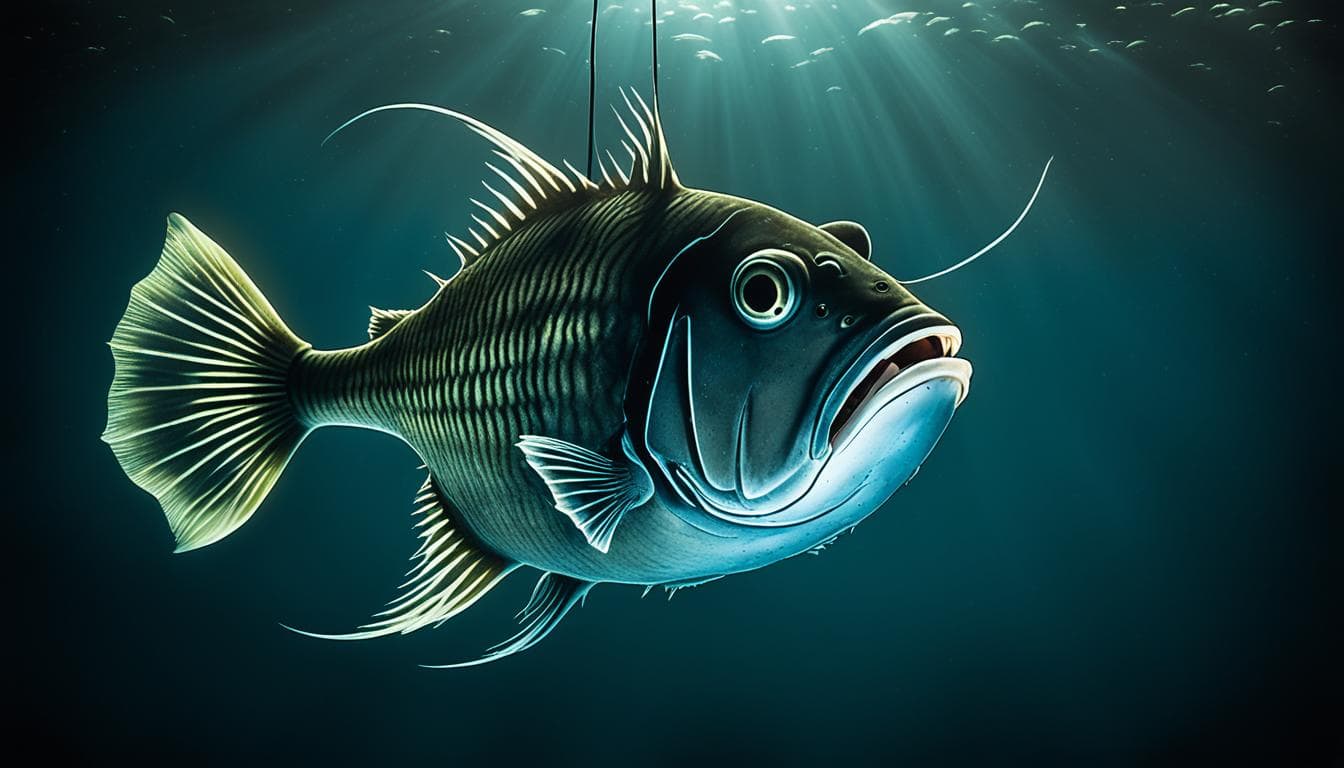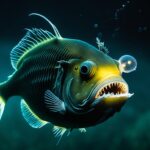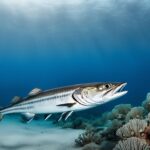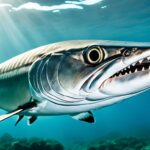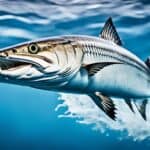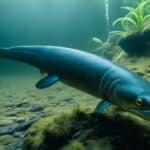Anglerfish are fascinating predators living in the deep, dark ocean. They have a special way of hunting that’s worth learning about. They use a structure called the illicium, like a fishing rod, to catch prey. This unique feature helps them survive in the dark depths.
Anglerfish have a special trick to catch food in the dark. They use the illicium to lure prey. This method is key to their survival in the deep sea.
Understanding Anglerfish Hunting Behavior
Anglerfish have a unique way of hunting that shows how well they’ve adapted to life in the deep ocean. They have special features that help them catch prey in the dark. These fish have traits that make them great hunters.
Characteristics of Anglerfish as Predators
Anglerfish have big, sharp teeth and mouths shaped like a crescent moon. These features are perfect for catching prey. They also have a special lure that attracts other sea creatures. This lure brings prey close, making it easy for the anglerfish to grab them.
Key Differences Between Male and Female Anglerfish
The males and females of anglerfish are very different, which is important for their survival. Females are much bigger than males. Males are much smaller and don’t hunt for food. They rely on the females for food, which helps them save energy.
In some species, males even attach themselves to the female’s body. This is a unique way of life known as sexual parasitism.
| Feature | Male Anglerfish | Female Anglerfish |
|---|---|---|
| Size | Small | Large |
| Hunting Activity | Does not hunt | Active predator |
| Symbiotic Relationship | Merges with female | Provides nutrients |
| Energy Usage | Conserves energy | Requires energy for hunting |
How do anglerfish hunt?
Anglerfish are amazing predators with unique hunting ways. They live in the dark ocean and use special skills to catch food. Their hunting methods are quite effective.
Unique Features of Anglerfish Hunting Techniques
Anglerfish have a special fin called the illicium above their heads. It looks like a fishing rod. They use it to lure prey close.
The illicium helps them catch food by drawing in other sea creatures. Anglerfish can move their illicium with great precision. This skill is key to their hunting success.
The Role of Luminescence in Attracting Prey
Luminescence is a big part of how anglerfish hunt. They have a special light at the tip of their illicium. This light comes from bacteria that glow.
This glowing lure attracts prey in the dark ocean. It looks like natural food, helping anglerfish catch their prey. This clever use of light shows how well anglerfish adapt to their environment.
Anglerfish Feeding Habits You Should Know
Anglerfish have unique ways of hunting that show their smart hunting skills and how they fit into their ocean world. They eat a wide variety of food, which is key to their survival in a tough ocean. This varied diet helps them live in places where food is scarce.
Diverse Diet of Anglerfish
Anglerfish mainly eat smaller fish, crustaceans, and sometimes even other anglerfish. Their diet is diverse, helping them survive in deep ocean depths where food is hard to find. They can catch prey much bigger than themselves, up to twice their size, showing their hunting skill. They have sharp teeth and a stretchy stomach, making it easy for them to eat hard-to-catch prey.
Adaptability to Their Environment
Anglerfish are very adaptable, which helps them hunt well. They can live in both deep and shallow waters, using what’s available to them. This flexibility helps them stay strong in the ever-changing deep sea. They can change how they hunt based on their surroundings, which helps them survive and be top predators.
Understanding the Anglerfish Lure Mechanism
The anglerfish’s lure is a key part of its survival. It has a special feature called the illicium on its head. This helps it catch food in the dark ocean depths.
The Structure and Function of the Illicium
The illicium looks like a modified dorsal fin ray. It lets the anglerfish move and look like prey. This trick helps it catch food by making it seem like an easy meal.
The esca, with its glowing bacteria, is a big part of this trick. It shines a light that fish find interesting, bringing them closer to the anglerfish.
How Symbiotic Bacteria Contribute to Bioluminescence
Symbiotic bacteria live in the anglerfish and make it glow. They live in the esca and light up the area to attract fish. This helps the anglerfish catch more food.
This relationship is good for both the anglerfish and the bacteria. The anglerfish keeps the bacteria safe, and the bacteria help the fish hunt better. It shows how nature has found clever ways for survival.
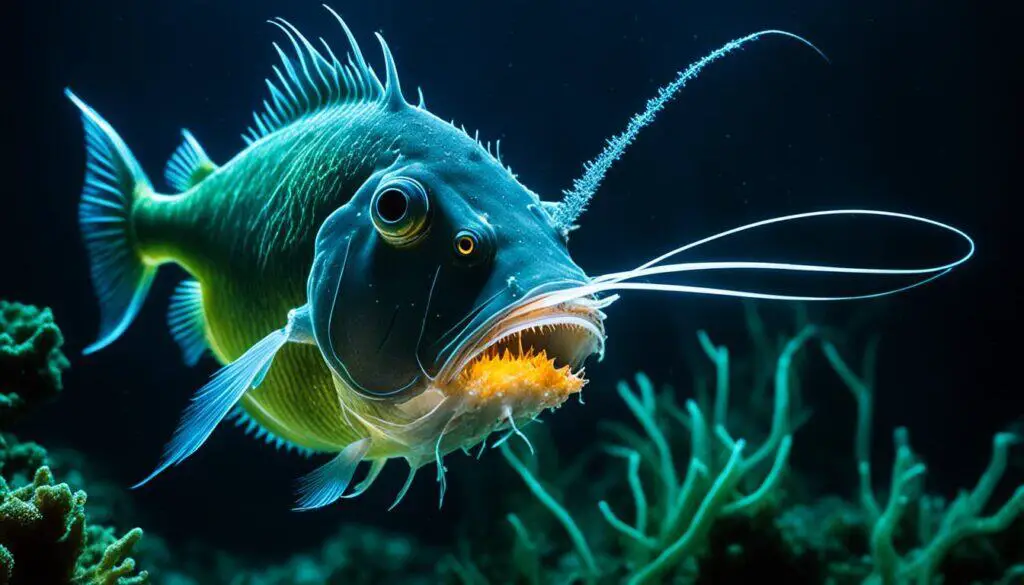
Deep-Sea Anglerfish Predation Strategies
The deep-sea anglerfish has amazing ways to hunt in the dark depths. These strategies help them survive in the dark ocean.
Adaptations for Hunting in Darkness
In the deep ocean, the anglerfish has special hunting adaptations in darkness. They have big mouths with sharp teeth to catch prey. Their bioluminescent lures do two things: they draw in prey and light up the dark. These features help the anglerfish find food, making them good hunters.
The Importance of Ambush Tactics
Ambush tactics are key for the deep-sea anglerfish predation strategy. Many species stay still, waiting for prey to come close. This way, they save energy and can survive in places where food is rare. Their patience helps them catch prey successfully, showing how important it is in hunting.
Anglerfish Prey Species
Anglerfish have fascinating feeding habits that show how ocean ecosystems work. They hunt a wide variety of prey, which is key to their survival. Their diet varies based on what’s available in their home waters. This part looks at what anglerfish mainly eat and how big their prey is.
Main Types of Prey Targeted by Anglerfish
Anglerfish are skilled hunters, eating many sea creatures. They mostly eat:
- Small fish
- Crustaceans
- Other invertebrates
- Occasionally larger fish, depending on the anglerfish species
They catch their prey using clever hunting methods. This helps them surprise and catch their food easily.
Impact of Prey Size on Hunting Success
Prey size is very important for anglerfish hunting. They can eat prey bigger than themselves, sometimes even more than double their size. But, there are factors to consider:
- Prey mobility: Bigger prey can move fast, making it hard to catch.
- Energy expenditure: Catching big prey takes a lot of energy, which affects hunting success.
- Digestive capabilities: Eating large prey needs a special way of digesting it.
This shows how anglerfish and their prey interact. It’s key to know what they eat and how big their prey is.
Anglerfish Hunting Adaptations
Anglerfish have unique hunting adaptations that help them thrive in the dark ocean. Their success as predators comes from their physical features and smart hunting skills. These features and skills make them great at catching prey.
Physical Features Enhancing Hunting Efficiency
Anglerfish have teeth that are perfectly angled for catching prey. These teeth help them hold onto slippery fish and make it hard for them to get away. They also have big stomachs that let them eat large meals compared to their size. This makes them powerful hunters in the deep ocean.
Behavioral Adaptations for Capture
Anglerfish also have smart ways of catching prey. They move little to avoid being seen and blend into the dark sea. When it’s time, they strike fast to catch their food before it can escape. Their mix of physical and behavioral traits makes them top hunters in the deep sea.
FAQ
How do anglerfish hunt?
Anglerfish use a special lure called the illicium to hunt. This lure looks like a small fish or crustacean, drawing in prey. Once close, the anglerfish quickly grabs its meal in the deep sea.
What are the characteristics of anglerfish as predators?
Anglerfish have big, sharp teeth and mouths shaped like crescents. They wait quietly until prey is near, then strike fast. This ambush helps them catch their food in the deep sea.
What are the key differences between male and female anglerfish?
Female anglerfish are much bigger than males. They hunt and store food for both. Males are smaller and live with females, getting nutrients from her body in a unique way.
What unique features enhance anglerfish hunting techniques?
The anglerfish’s illicium is a special fin ray that lures prey and helps catch them. It has a light at the tip that attracts other fish, making hunting easier in the dark.
How does luminescence play a role in anglerfish hunting?
The esca on the anglerfish has glowing bacteria that light up. This light draws other fish to the anglerfish, helping it catch prey in the dark ocean.
What are the feeding habits of anglerfish?
Anglerfish eat a variety of things like small fish, crustaceans, and sometimes other anglerfish. They can adapt to different places and eat different foods, making them flexible hunters.
How do anglerfish adapt to their environment for hunting?
Anglerfish can live in many places, from open water to the ocean floor. They stay still and wait for food, which saves energy in places where food is hard to find.
What is the structure and function of the illicium?
The illicium comes from the anglerfish’s head and is used as a lure and to catch prey. It’s a key part of how they hunt in the dark, making them effective predators.
How do symbiotic bacteria contribute to bioluminescence in anglerfish?
The bacteria in the esca give off light, helping the anglerfish attract prey. This helps both the fish and the bacteria, as the bacteria get a home and the fish get food.
What adaptations allow deep-sea anglerfish to hunt effectively?
Anglerfish have big mouths and special teeth for catching prey. They also use ambush tactics to hunt in the dark deep sea, making them well-suited to their environment.
What types of prey do anglerfish typically target?
Anglerfish eat small fish, crustaceans, and sometimes bigger prey that’s up to twice their size. They can do this because they have big stomachs and good hunting skills.
How does prey size impact anglerfish hunting success?
Catching big prey can be hard for anglerfish, but they have ways to do it. They have special features that help them catch larger fish, making them successful hunters.
What physical features enhance anglerfish hunting efficiency?
Anglerfish have teeth that help them hold onto prey and big stomachs for eating large meals. These features help them be good at catching food in the deep sea.
What behavioral adaptations do anglerfish have for capture?
Anglerfish don’t move much and strike quickly when prey comes close. This way of hunting helps them catch food in the deep sea where it’s hard to find.

